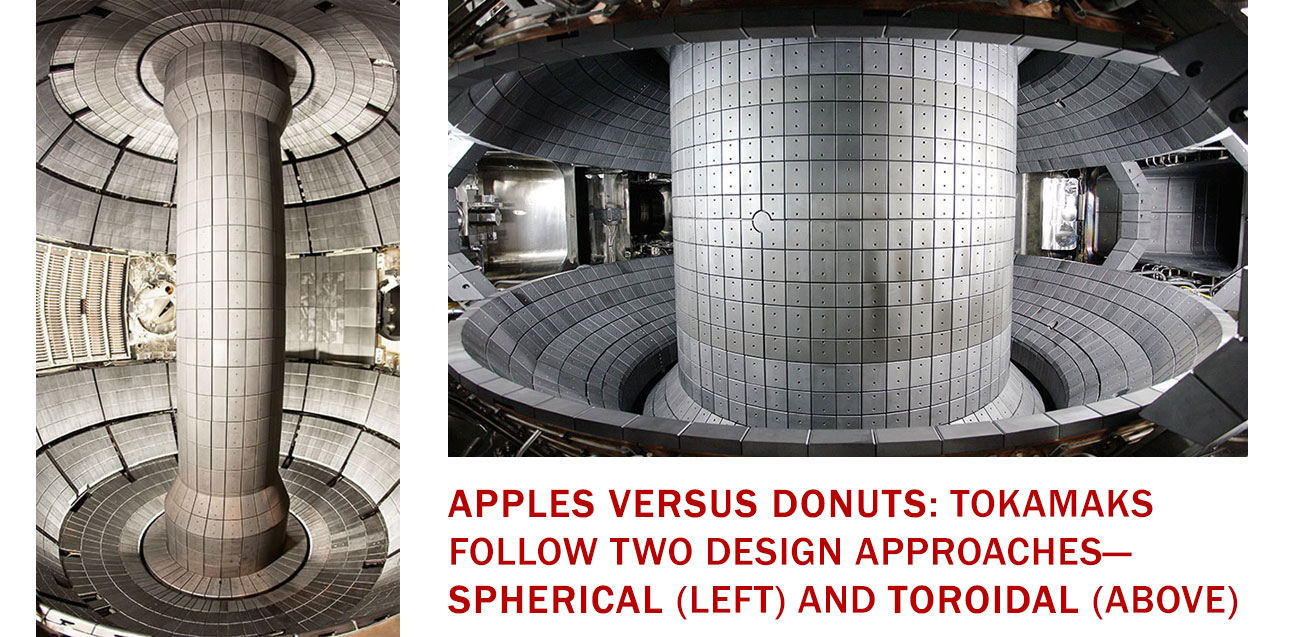
How will the future of fusion-powered nuclear energy take shape?
It could boil down to a question of apples versus donuts.
For engineers trailblazing toward the still-long-off goal of a sustainable, safe, and economically feasible fusion reactor, the choice represents two different design approaches to tokamaks, the giant devices used to study the behavior of fusion plasmas.
“Conventional tokamaks, like the DIII-D National Fusion Facility here in the U.S. or KSTAR in South Korea, have a toroidal, or donut, shape,” says mechanical engineering and mechanics professor Eugenio Schuster.
Spherical tokamaks, such as the National Spherical Torus Experiment Upgrade (NSTX-U) at Princeton Plasma Physics Laboratory (PPPL), “while still technically a donut shape, have a very small hole in the middle,” he explains, “so they look more like a sphere.” (Visualize a cored apple.)
Schuster leads Lehigh’s Plasma Control Group, which has been awarded more than $1.5 million from the Department of Energy to conduct research at NSTX-U. The work will help physicists answer key questions about the spherical tokamak concept and contribute to the eventual design of a compact, efficient fusion reactor.
Tokamaks confine a plasma—the same superheated electrically charged gas where nuclear fusion takes place in the sun and the stars—within magnetic fields. This “invisible bottle” prevents the plasma (at around 100 million degrees Celsius) from touching the inner wall of the tokamak. In present tokamak “devices” like DIII-D and NSTX-U, researchers study the physics of the plasma while avoiding a significant amount of nuclear reactions that would generate undesirable levels of radioactivity. Understanding the dynamics of this plasma will enable the development of tokamak “reactors,” where energy generation will be the goal.

NSTX-U is coming back online following a shutdown caused by a malfunctioning magnetic coil in 2016, when it was resuming operations after a four-year upgrade. Schuster is confident in the re-engineered device and looks forward to using its upgraded capabilities to explore the possibilities of the spherical tokamak geometry.
“For Lehigh to be part of this relaunch, it is an honor for us,” he says. “And we’re very excited about what this machine will be able to do.”
One of the priorities for NSTX-U, Schuster says, “is to get ‘advanced plasmas,’ which have greater stability and can work longer in a steady state, or without the help of inductive means of current. They have high performance, in terms of pressure. The higher the pressure, the more efficient the nuclear fusion reaction will be.”
Schuster and his multidisciplinary team will develop models to better understand the dynamics of these types of plasmas and write physics-based codes to predict their behavior. The models will lead to the design of control strategies to effectively regulate the plasma in closed loop.
The collaboration will include Tariq Rafiq (principal research scientist in the mechanical engineering and mechanics department), grad students, and a postdoc, along with one of Schuster’s former PhD students, Mark Daniel Boyer, a staff research scientist at PPPL.
As a Scientist Fellow in Plasma Control for ITER (the world’s first nuclear reactor based on fusion, currently under construction in France), Schuster is part of the effort to get that facility operational by 2025. It will likely take another 10 to 15 years to produce energy from fusion at the reactor’s intended target.
His experiments at NSTX-U take an even longer view: “If we demonstrate that there are benefits, the next reactor might use this more compact, spherical configuration that we intend to explore at PPPL.”
Credits: NSTX-U photos, Elle Starkman/PPPL Communications; KSTAR photo, Korea Institute of Fusion Energy
